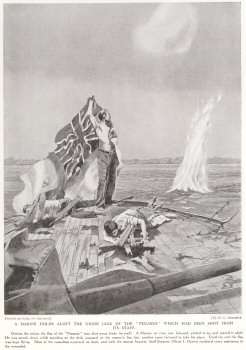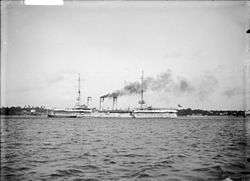Battle of Zanzibar
| Battle of Zanzibar | |||||||
|---|---|---|---|---|---|---|---|
| Part of World War I | |||||||
 A Royal Marine, holding up the White Ensign aboard HMS Pegasus during the battle off Zanzibar. | |||||||
| |||||||
| Belligerents | |||||||
|
|
| ||||||
| Commanders and leaders | |||||||
|
|
| ||||||
| Strength | |||||||
| One light cruiser |
One protected cruiser one tugboat | ||||||
| Casualties and losses | |||||||
| none |
One cruiser sunk one tugboat damaged 39 killed 55 wounded | ||||||
The Battle of Zanzibar took place between the German Kaiserliche Marine and the British Royal Navy early in the First World War of 1914-1918. The German cruiser SMS Königsberg, while taking on coal in the delta of the Rufiji River (German East Africa), learned that a British cruiser—HMS Pegasus, which had been part of the Royal Navy's Cape Squadron sent to counter Königsberg—had put in at Zanzibar for repairs. Königsberg′s captain—Commander Max Looff—decided to attack Pegasus while she was in port.
On 20 September 1914 Königsberg sailed past the picket ship HMS Helmuth at the entrance to Zanzibar harbour. Helmuth was unable to warn Pegasus of Königsberg′s approach, with the result that when Konigsberg opened fire she took Pegasus entirely by surprise. As a result, Pegasus suffered heavy damage before she was even able to return fire.
Königsberg′s guns out-ranged those on Pegasus, which was consequently unable to damage her opponent. The one-sided battle ended in a German victory, Pegasus sank later that day, having lost 38 crew dead.
Background
Shortly after the outbreak of the First World War, on 19 September 1914, Commander Max Looff of the light cruiser SMS Königsberg was coaling in the Rufuji Delta, when he learned from coast watchers that a British warship had entered Zanzibar harbour.[1] Looff assumed the cruiser at Zanzibar was either HMS Astraea or HMS Pegasus and ordered an immediate attack. As Königsberg had been recently resupplied, she was prepared for battle. Königsberg left on the afternoon tide for her run to Zanzibar.
The protected cruiser Pegasus, under the command of Captain John Ingles,[2] had just left the company of HMS Astraea and Hyacinth for repairs at Zanzibar to her boilers and engines.[3] Also at Zanzibar, the British had armed the captured German tug HMS Helmuth with a 3-pounder gun and posted her as a picket ship at the entrance of the harbor.
Königsberg had been built in 1905 and was armed with ten 10.5 cm quick-firing guns, ten 5.2 cm anti-torpedo-boat pieces and two 18 in (460 mm) torpedo tubes. Pegasus—a Pelorus-class protected cruiser built in 1897—was armed with eight QF 4 inch guns, eight 3-pounders and two 18-inch torpedo tubes. Her complement consisted of 234 officers and men.
Battle
At dawn on 20 September, Königsberg entered the southern end of the Zanzibar approaches and sailed past the picket ship Helmuth, firing a few warning shots as she passed. Helmuth could neither stop the Königsberg from entering the harbour nor even warn Pegasus of the German cruiser′s approach.[4]
Once Koningsberg came within 9,000 yd (8,200 m) of Pegasus, she began firing salvos. Pegasus sat at anchor in Zanzibar Harbour, preparing steam and at that moment, was helpless. For about 20 minutes while Königsberg fired, Pegasus remained stationary.[1] Pegasus did raise the White Ensign and began firing, but her shells splashed into the water well short of Koningsberg. The light cruiser slowly continued forward and fired until the range had closed to within 7,000 yd (6,400 m). One of the first British sailors wounded was gunnery officer Lieutenant Richard Turner, who suffered both of his legs being mangled by shrapnel. Despite his injuries, Turner rallied his men, telling them; "Keep it up, lads, we’re outclassed and done for; but damn them, and keep it up!"
The British continued their futile fight for around 20 minutes more, taking additional hits from Königsberg, the majority landing on Pegasus′ deck. Her ensign was shot away during the fight. Also, because the Germans were always at least 2,000 yd (1,800 m) beyond the range of Pegasus′ guns, no British rounds struck Königsberg.
Pegasus became holed near her waterline and began taking on water. All hope of defeating the Germans having gone, Ingles struck his colours and gave the order to abandon ship.[5] Pegasus later sank.
After Königsberg had finished with Pegasus, she fired a few parting shots at Helmuth, whose crew managed to abandon ship before one of the German cruiser's salvos struck the tug. Having achieved a clear victory, Königsberg turned around and headed back for the Rufiji Delta.[6]
Aftermath
The Royal Navy′s losses were Pegasus sunk and Helmuth damaged. Thirty-eight British sailors on Pegasus had died; another 55 sailors were wounded, most of whom had been top-side when hit. Staff Surgeon Alfred J. Hewitt was on the deck of Pegasus from the beginning to the end of the battle, aiding wounded sailors and marines. Captain Ingles later recognized Hewitt′s courageous behaviour in a report on the action. Although Helmuth had taken a hit from Königsberg, the damage to the tug was relatively minor and her crew managed to reboard her after Königsberg had sailed off. Only one man on board Helmuth died, a non-enlisted native working in the engine room.[7]
The hospital ship Gascon and the Scottish merchant ship SS Clan Macrae rescued the survivors of Pegasus. Twenty-four of the British sailors that died in the battle were buried in a mass grave in the naval cemetery on Grave island, Zanzibar, while 14 others were laid to rest at the town's cemetery before being moved in 1971 to the Dar es Salaam war cemetery. The British salvaged six of Pegasus′ guns from the wreck and later used them in the East African land campaign.[8]
Although Königsberg had suffered no hits or casualties, Looff′s plans to continue the offensive were soon cut short. One of her main engines failed. The British were watching the port of Dar es Salaam so she had to return to the Rufiji River delta to await the overland transport of spare parts. The British soon discovered Königsberg′s location and blockaded her. They damaged her beyond repair in the Battle of Rufiji Delta when they were able to bring up the monitors HMS Mersey and Severn that July.[9]
See also
Citations
- 1 2 Farwell 1986, p. 132.
- ↑ "John Alexander Ingles". Lives of the First World War, Imperial War Museum. Retrieved 2016-09-03.
- ↑ Halpern 1995, p. 77.
- ↑ Newbolt 1928, p. 308.
- ↑ Edwards 1995, p. 68.
- ↑ Edwards 1995, p. 69.
- ↑ Crofton 1953, p. 7.
- ↑ Chisholm 1922, p. 877.
- ↑ Edwards 1995, p. 70.
References
- Chisholm, Hugh (1922). The Encyclopædia Britannica, The Twelfth Edition, Volume 1. New York: The Encyclopædia Britannica Company.
- Crofton, Richard Hayes (1953). Zanzibar Affairs, 1914–1933. London: F. Edwards.
- Edwards, Bernard (1995). Salvo!: Classic Naval Gun Actions. London: Arms & Armour Press. ISBN 1-55750-796-1.
- Farwell, Byron (1986). The Great War in Africa, 1914–1918. New York: W.W. Norton & Company, Inc. ISBN 978-1-85728-498-0.
- Halpern, Paul G. (1995). A Naval History of World War I. US Naval Institute Press. ISBN 1-55750-352-4.
- Newbolt, H. (1928). History of the Great War Based on Official Documents: Naval Operations. Volume IV (N & M Press 2003 ed.). London: Longmans. ISBN 1-84342-492-4.
Further reading
- Corbett, Julian (1920). Naval Operations. London: Longmans, Green and Co.
- Patience, Kevin (2001). Konigsberg: A German East African Raider.
- Patience, Kevin (2001). Shipwrecks and Salvage on the East African Coast.
Coordinates: 6°8′54″S 39°11′36″E / 6.14833°S 39.19333°E

.jpg)